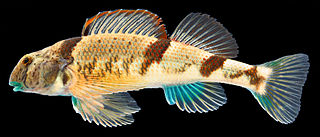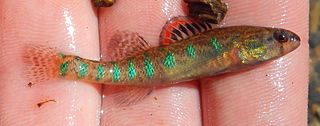The coldwater darter is a species of freshwater ray-finned fish, a darter from the subfamily Etheostomatinae, part of the family Percidae, which also contains the perches, ruffes and pikeperches. It is endemic to the United States, where it occurs in the Coosa River system of Georgia, Alabama, and Tennessee.
The redband darter is a species of freshwater ray-finned fish, a darter from the subfamily Etheostomatinae, part of the family Percidae, which also contains the perches, ruffes and pikeperches. It is endemic to the state of Tennessee in the eastern United States.

The johnny darter is a species of freshwater ray-finned fish, a darter from the subfamily Etheostomatinae, part of the family Percidae, which also contains the perches, ruffes and pikeperches. It is native to shallow waters throughout North America east of the Rocky Mountains.

The blenny darter is a species of freshwater ray-finned fish, a darter from the subfamily Etheostomatinae, part of the family Percidae, which also contains the perches, ruffes and pikeperches. It is a poorly known species which occurs in Alabama and Tennessee where it inhabits swift riffles.
The naked sand darter is a species of freshwater ray-finned fish, a darter from the subfamily Etheostomatinae, part of the family Percidae, which also contains the perches, ruffes and pikeperches. It is found in the south-eastern United States.

The mud darter is a species of freshwater ray-finned fish, a darter from the subfamily Etheostomatinae, part of the family Percidae, which also contains the perches, ruffes and pikeperches. It is endemic to the lowlands of the Mississippi River basin from Wisconsin and Minnesota south to Louisiana and East Texas. It is also found in the drainages of the Sabine and Neches Rivers of Texas and Louisiana. It can be found in slow-moving waters on riffles in rivers, as well as in creeks, swamps, lakes, and reservoirs. It mostly consumes the larvae of midges and blackflies. This species can reach a length of 7.1 cm (2.8 in), though most only reach a length of 5 cm (2.0 in).
The emerald darter, is a species of freshwater ray-finned fish, a darter from the subfamily Etheostomatinae, part of the family Percidae, which also contains the perches, ruffes and pikeperches. It is found only in northern and eastern Kentucky and northeastern Tennessee.

The bluntnose darter is a species of freshwater ray-finned fish, a darter from the subfamily Etheostomatinae, part of the family Percidae, which also contains the perches, ruffes and pikeperches. It is found in eastern North America where it is found in slower moving and still waters.

The Coosa darter is a species of freshwater ray-finned fish, a darter from the subfamily Etheostomatinae, part of the family Percidae, which also contains the perches, ruffes and pikeperches. It is endemic to the eastern United States.
The saffron darter is a species of freshwater ray-finned fish, a darter from the subfamily Etheostomatinae, part of the family Percidae, which also contains the perches, ruffes and pikeperches. It is endemic to the eastern United States, where it is found in streams and creeks in Kentucky and Tennessee.

Etheostoma gracile, the slough darter, is a small species of ray-finned fish, a darter from the subfamily Etheostomatinae, part of the family Percidae which includes the perches, ruffs and pike-perches. It inhabits slow to moderately flowing waters and with substrates that are predominantly mud, silt, or sand. Major food sources include chironomids, copepods, and cladocerans, as well as mayflies in the spring. Adults reach 35 to 50 mm total length. It is one of the 324 species of fish found in Tennessee.
The stripetail darter is a species of freshwater ray-finned fish, a darter from the subfamily Etheostomatinae, part of the family Percidae, which also contains the perches, ruffes and pikeperches. It is endemic to the eastern United States. It is found in small rivers and streams in the states of Tennessee, Ohio, Kentucky, Illinois, Alabama, Georgia, and Mississippi. Males are a golden-orange color with black barring on the fins, and grow to a length of about 2.8 in (7 cm). This fish feeds on midge larvae and other small invertebrates. It breeds in the spring; eggs are attached to the substrate, often under slab rocks, where they are guarded by the male. The population trend of this fish seems to be stable and it is a common species with numerous sub-populations over a wide range, and the International Union for Conservation of Nature has assessed its conservation status as being of "least concern".
The blackfin darter is a species of freshwater ray-finned fish, a darter from the subfamily Etheostomatinae, part of the family Percidae, which also contains the perches, ruffes and pikeperches. It is endemic to the eastern United States where it occurs in the Tennessee River drainage, being found from the Paint Rock River to the Duck River system. It is an inhabitant of small rivers and creeks, living in small pools and nearby riffles. This species can reach a length of 8.8 centimetres (3.5 in) TL.
The barcheek darter is a species of freshwater ray-finned fish, a darter from the subfamily Etheostomatinae, part of the family Percidae, which also contains the perches, ruffes and pikeperches. It is endemic to the eastern United States where it is only known to occur in the states of Kentucky and Tennessee in the Cumberland River drainage from the Big South Fork down to the Obey River. It is an inhabitant of smaller rivers, streams and creeks where it lives in small, rocky pools. This species can reach a length of 8.4 centimetres (3.3 in) TL though most only reach a length of 5 centimetres (2.0 in).

The snubnose darter is a species of freshwater ray-finned fish, a darter from the subfamily Etheostomatinae, part of the family Percidae, which also contains the perches, ruffes and pikeperches. It is endemic to the southeastern United States.
The slabrock darter is a species of freshwater ray-finned fish, a darter from the subfamily Etheostomatinae, part of the family Percidae, which also contains the perches, ruffes and pikeperches. It is endemic to the eastern United States. It occurs in the drainages of the lower Cumberland River and the lower Tennessee River in the states of Kentucky and Tennessee. It inhabits rocky pools in smaller rivers and streams, and along the rocky margins of larger streams and bodies of water. This species preys on insect larvae and extremely small crustaceans. It can reach a length of 6.2 centimetres (2.4 in) TL though most only reach about 4.1 centimetres (1.6 in). The specific name honors the vertebrate zoologist, Dr. Philip Wayne Smith (1921-1986).
The spottail darter is a species of freshwater ray-finned fish, a darter from the subfamily Etheostomatinae, part of the family Percidae, which also contains the perches, ruffes and pikeperches. It is endemic to the eastern United States. It is found in the Ohio River basin and in the Red River system of the Cumberland River drainage. It inhabits rocky pools and nearby riffles of flowing waters up to the size of small rivers.

The gulf darter is a species of freshwater ray-finned fish, a darter from the subfamily Etheostomatinae, part of the family Percidae, which also contains the perches, ruffes and pikeperches. It is found in Louisiana, Mississippi, Alabama, Florida, Tennessee, and Kentucky. It is a colorful fish, males having vertical barring of red-orange and blue-green near the tail, growing to a length of about 7.8 centimeters (3.1 in). It is typically found in small and medium-sized creeks, often in very shallow water. It occurs over sandy bottoms and among aquatic vegetation such as Sparganium americanum, foraging among the plants and organic debris for insect larvae and small invertebrates. The International Union for Conservation of Nature has assessed its conservation status as being of "least concern".

The rush darter is a rare and endangered species of freshwater ray-finned fish, a darter from the subfamily Etheostomatinae, part of the family Percidae, which also contains the perches, ruffes and pikeperches. It is endemic to Alabama in the United States, where it occurs in three river systems. It was federally listed as an endangered species of the United States on August 9, 2011.
Etheostoma obama, the spangled darter, is a species of freshwater ray-finned fish, a darter from the subfamily Etheostomatinae, part of the family Percidae, which also contains the perches, ruffes and pikeperches. It is endemic to the eastern United States where it is only known to occur in the Duck River and the Buffalo River, both in Tennessee.










